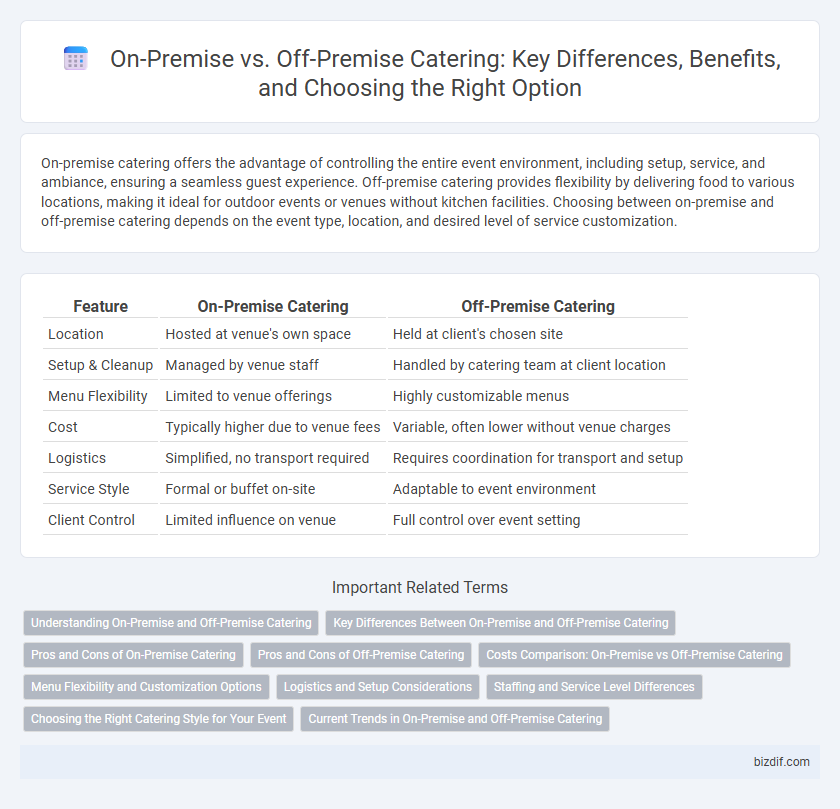On-premise catering offers the advantage of controlling the entire event environment, including setup, service, and ambiance, ensuring a seamless guest experience. Off-premise catering provides flexibility by delivering food to various locations, making it ideal for outdoor events or venues without kitchen facilities. Choosing between on-premise and off-premise catering depends on the event type, location, and desired level of service customization.
Table of Comparison
| Feature | On-Premise Catering | Off-Premise Catering |
|---|---|---|
| Location | Hosted at venue's own space | Held at client's chosen site |
| Setup & Cleanup | Managed by venue staff | Handled by catering team at client location |
| Menu Flexibility | Limited to venue offerings | Highly customizable menus |
| Cost | Typically higher due to venue fees | Variable, often lower without venue charges |
| Logistics | Simplified, no transport required | Requires coordination for transport and setup |
| Service Style | Formal or buffet on-site | Adaptable to event environment |
| Client Control | Limited influence on venue | Full control over event setting |
Understanding On-Premise and Off-Premise Catering
On-premise catering involves food service provided at the venue owned or managed by the caterer, offering controlled environments with dedicated kitchen facilities and staff. Off-premise catering delivers food to an external location, requiring portable equipment and flexible setup to adapt to various event spaces and client needs. Understanding these distinctions helps clients choose services based on event size, location preferences, and logistical convenience.
Key Differences Between On-Premise and Off-Premise Catering
On-premise catering involves food preparation and service at the venue itself, offering greater control over ambiance and immediate customer service, while off-premise catering delivers meals to a separate location, emphasizing logistics and transport efficiency. Key differences include the scope of kitchen facilities, staffing requirements, and flexibility in menu customization, with on-premise catering typically allowing for more complex setups and off-premise catering prioritizing portability and setup simplicity. Cost structures also vary, as on-premise catering often incurs venue usage fees whereas off-premise catering focuses on delivery and setup charges.
Pros and Cons of On-Premise Catering
On-premise catering offers the advantage of controlled environment and immediate access to facilities, ensuring seamless coordination and fresh food service directly at the venue. It reduces transportation risks and allows for tailored ambiance customization, enhancing the client's event experience. However, higher operational costs and limited venue options can pose challenges compared to off-premise catering alternatives.
Pros and Cons of Off-Premise Catering
Off-premise catering offers flexibility in venue selection, allowing events to be held in diverse locations such as homes, parks, or conference centers, while reducing the need for on-site kitchen facilities. This type of catering often requires extensive logistical planning, including transportation of food, equipment, and staff, which can increase costs and complexity compared to on-premise services. However, off-premise catering provides opportunities for customized event experiences and scalability for larger guest counts, balancing convenience with the challenges of menu quality maintenance during transit.
Costs Comparison: On-Premise vs Off-Premise Catering
On-premise catering often involves higher venue rental and staffing costs, as the event is hosted at the caterer's location, ensuring controlled service quality but limited flexibility. Off-premise catering typically incurs additional expenses for transportation, setup, and equipment rental, yet offers greater adaptability by allowing events to be held at varied locations. Comparing overall costs depends on factors like guest count, menu complexity, and location logistics, with off-premise catering potentially increasing costs due to delivery and site-specific requirements.
Menu Flexibility and Customization Options
On-premise catering offers greater menu flexibility and customization options, allowing clients to tailor dishes to specific tastes and dietary preferences with immediate chef consultation. Off-premise catering often features set menus designed for easy transport and quick service, limiting real-time adjustments and specialized requests. Clients seeking personalized culinary experiences typically prefer the dynamic offerings available in on-premise catering environments.
Logistics and Setup Considerations
On-premise catering requires coordination with the venue's existing facilities, which can simplify logistics but may impose restrictions on kitchen access and space. Off-premise catering demands careful planning for transportation, equipment delivery, and setup at the client's location, ensuring food safety and timely service despite variable environments. Both types necessitate detailed arrangements for staffing, equipment rental, and compliance with health regulations to optimize the event's flow and quality.
Staffing and Service Level Differences
On-premise catering requires a dedicated staff skilled in managing food preparation, presentation, and direct guest interaction within the venue, ensuring a seamless and personalized service level. Off-premise catering demands flexible staffing capable of transporting, setting up, and efficiently serving in diverse locations while maintaining food quality and timing precision. The service level for on-premise events typically allows for more customization and immediate issue resolution, whereas off-premise catering emphasizes logistical coordination and scalable service teams.
Choosing the Right Catering Style for Your Event
On-premise catering offers the advantage of utilizing the venue's existing facilities, enabling seamless coordination and immediate service for events like corporate meetings or weddings. Off-premise catering provides flexibility to host events at any location, ideal for outdoor gatherings or private celebrations requiring customized setup and logistics. Evaluating factors such as guest count, event type, and venue infrastructure is essential to select the catering style that ensures optimal food quality, service efficiency, and overall guest experience.
Current Trends in On-Premise and Off-Premise Catering
On-premise catering continues to thrive in providing immersive dining experiences with customizable decor and real-time service, appealing to events demanding high social interaction. Off-premise catering gains momentum due to its flexibility, contactless delivery options, and cost efficiency, especially driven by remote work and virtual event trends. Hybrid models integrating live streaming and personalized meal kits further bridge the gap, setting new standards in the evolving catering industry.
On-premise catering vs Off-premise catering Infographic

 bizdif.com
bizdif.com